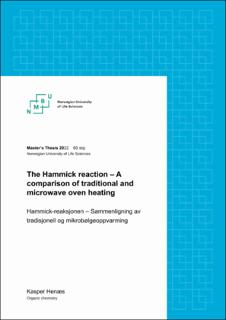| dc.contributor.advisor | Nolsøe, Jens M. J. | |
| dc.contributor.advisor | Stenstrøm, Yngve Henning | |
| dc.contributor.author | Henæs, Kasper Aarkvisla | |
| dc.date.accessioned | 2022-12-19T11:58:14Z | |
| dc.date.available | 2022-12-19T11:58:14Z | |
| dc.date.issued | 2022 | |
| dc.identifier.uri | https://hdl.handle.net/11250/3038490 | |
| dc.description.abstract | 2-picolinic acid is a simple alkaloid that is produced in the human body. The compound has sparked interest in the medical field due to its relatively cheap production and the possibility of it being a precursor to new drugs. 2-picolinic acid react readily with carbonyl groups if heated through the Hammick reaction. The Hammick reaction include a simple decarboxylation and does not require any catalyst.
The goal of this thesis was to investigate the many carbonyl containing compounds that could be reacted with 2-picolinic acid through the Hammick reaction and optimize the possibility for cascade cyclization reactions. The work-up was done as easy as possible so that as many carbonyl compounds as possible could be tested. This would also make it easy to scale up the reaction if the need should arise.
This study proved that the Hammick reaction can be done in the microwave oven, reducing the reaction time from 24 hours to around 2 hours. This is significant due to the rearrangement of the intermediate azomethine ylid to pyridine. This rearrangement is irreversible.
To be able to get cascade cyclizations the carbonyl compounds that were reacted with 2- picolinic acid had to be prepared with allyl bromide from their 2-hydroxide counterparts. This step was hampered by Covid-19. The main focus of the investigation was limited to find the optimal conditions for the addition of the carbonyl compounds targeting starting materials for total syntheses of alkaloids. | en_US |
| dc.description.abstract | 2-pikolinsyre er et enkelt alkaloid som blir produsert i menneskekroppen. Forbindelsen har vekket interesse innen medisin fordi det er relativt billig å produsere og forbindelsen er lovende som et utgangspunkt for nye medisiner. 2-pikolinsyre reagerer med karbonylgrupper ved oppvarming gjennom Hammick reaksjonen. Hammick reaksjonen inkluderer en dekarboksylering og krever ingen katalysator.
Målet med denne oppgaven var å se på flere karbonyler-forbindelser som kunne reagere med 2-pikolinsyre gjennom Hammick-reaksjonen og optimalisere muligheten for kaskadesyklisering under reaksjonen. Opparbeidelsen ble gjort så enkel som mulig slik at så mange karbonyl-forbindelser kunne bli testet som mulig. En enkel opparbeidelse gjorde det også enkelt å skalere opp reaksjonen om det skulle bli nødvendig.
Det ble bevist at Hammick reaksjonen fungerer i mikrobølgeovn, reaksjonstiden ble redusert fra 24 timer til rundt 2 timer. Dette har betydning fordi azomethinylidet omleirer til pyridin. Denne omleiringen er irreversibel.
For å få kaskadesykliseringen til å skje måtte karbonylforbindelsene som skulle reageres med 2-pikolinsyre forberedes med allylbromid fra 2-hydroxid motpartene deres. Dette ble ikke gjennomført på grunn av Covid-19. Fokuset ble derfor skiftet til å finne de best egnet karbonylforbindelsene til å gå videre med. | en_US |
| dc.language.iso | eng | en_US |
| dc.publisher | Norwegian University of Life Sciences, Ås | en_US |
| dc.rights | Attribution-NonCommercial-NoDerivatives 4.0 Internasjonal | * |
| dc.rights.uri | http://creativecommons.org/licenses/by-nc-nd/4.0/deed.no | * |
| dc.title | The Hammick reaction : a comparison of traditional and microwave oven heating | en_US |
| dc.title.alternative | Hammick-reaksjonen : sammenligning av tradisjonell og mikrobølgeoppvarming | en_US |
| dc.type | Master thesis | en_US |
| dc.description.localcode | M-KJEMI | en_US |

